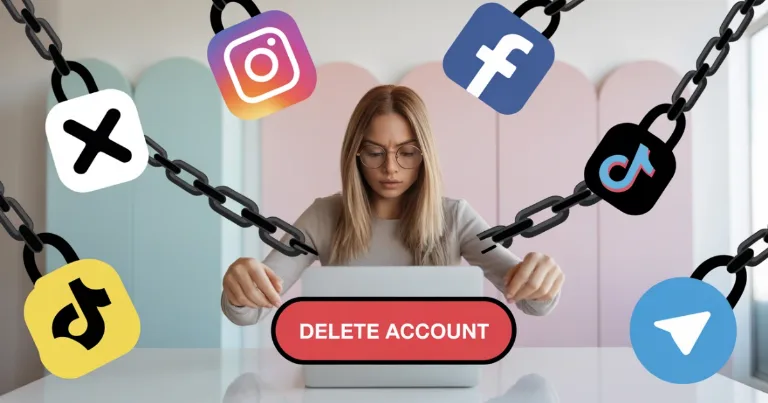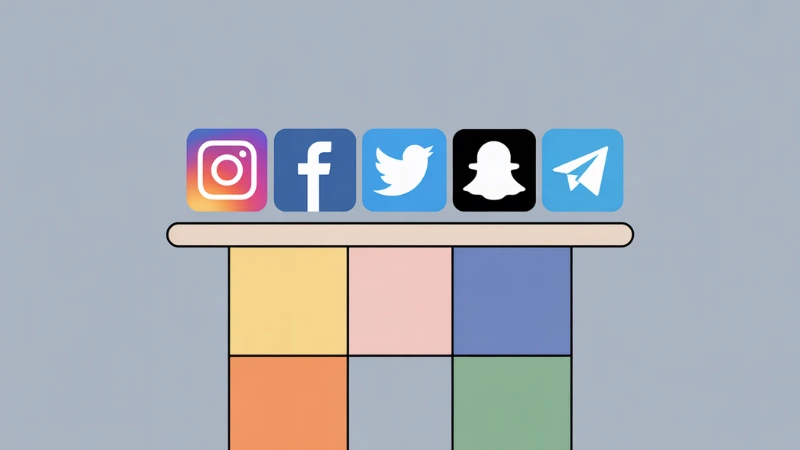Why Deleting a Social Media Account Is Harder Than You Think

I have deleted a few social media accounts over the years, and every single time it felt harder than it needed to be. Signing up takes a minute. Deleting takes patience and sometimes a little luck.
Each platform handles it differently. Instagram hides the option deep in settings. Telegram won’t even let you delete if you lose your phone number. Facebook makes you wait through a 30-day grace period before deletion starts, and even then some data can linger in backups for months. The details change, but the pattern is the same. Leaving is never as simple as joining.
That’s what I want to unpack here. Why deleting an account is so complicated, how different apps play by their own rules, and what you should do before you pull the trigger on deleting yours.
The Illusion of Control
When you sign up for a new account, it feels like everything is in your hands. You choose the username, upload the photos, and share what you want. But the second you try to delete that account, you realize the control was never really yours.
Platforms are built to keep you in. They want big user numbers, even if some of those users are inactive. That’s why deleting isn’t one simple button. It’s a process that makes you stop, click around, and sometimes even second-guess your decision.
Take Telegram for example. If you lose your phone number, there’s no way to delete the account yourself. You just have to wait until it auto-deletes after months of inactivity. I wrote a full guide about that here: How to Delete Your Telegram Account If You Lost Your Password and Can’t Log In.
Some apps give you a temporary “deactivation” option instead of true deletion. Others stretch things out with long waiting periods. The message is the same across the board. You can join anytime you want, but leaving will always take more effort.
Different Apps, Different Rules

Every social media platform has its own way of handling deletion. The end result might be the same, your account disappears, but how you get there is completely different.
For example, Instagram gives you two choices. You can deactivate your account for a while or delete it permanently. The deletion process is not instant. Instagram keeps your data hidden for 30 days in case you change your mind. If you want the exact steps, I put together a clear guide here: How to Delete Instagram Account.
Here’s a quick comparison of how the main platforms handle account deletion:
| Platform | Deletion Process | Waiting Period | Extra Notes |
|---|---|---|---|
| Deactivate or delete | 30 days hidden before removal | Data may stay in backups up to 90 days | |
| Deactivate or delete | 30 days to cancel deletion | Backups may take 90 days to clear | |
| Twitter / X | Deactivation first | 30 days (up to 12 months for paid users) | Permanent after window passes |
| TikTok | Delete via settings | 30 days deactivation | Then permanently removed |
| Snapchat | Deactivation first | 30 days deactivation | Then permanently removed |
| Telegram | Auto-delete after inactivity | Default 6 months (changeable to 1, 3, or 12 months) | No manual delete if locked out |
Each app presents it differently, but the idea is the same. They do not want you to leave quickly.
Why Platforms Make It Complicated
At first glance, the rules look like they are all about security. Telegram says they do not let you delete without logging in because they need to make sure it is really you. Instagram and Facebook give you a grace period so you can change your mind before your profile is gone forever. On paper, those sound like good reasons.
But there is another side to it. These platforms want to keep their user numbers high. The longer your account sits around, the better the stats look. Even if you are not active, you are still counted as a user until the deletion is final. That is why so many apps add waiting periods, hidden menus, and deactivation options instead of letting you hit one button and walk away.
The harder it is to leave, the more people will give up and stay.
What Actually Happens After Deletion
Deleting your account rarely means it vanishes right away. Most platforms build in a waiting period before anything is truly gone. During that time, your profile is hidden but the account still exists in the background.
On Instagram, your account stays invisible for 30 days before it is permanently removed, although it can take up to 90 days for all of your data to be cleared from backups. Facebook works the same way. Twitter, TikTok, and Snapchat follow a similar pattern, starting with deactivation and then moving to deletion after about a month.
Even after that, some data may stay in server backups for longer. Companies say this is for technical reasons like recovery and security. Whatever the reason, the point is clear. Deleting is not instant. Your account fades out slowly over weeks or months until it is fully erased.
What You Should Do Before Deleting Any Account
Before you hit delete, there are a few things worth doing so you do not lose anything important.
-
Download your data. Most platforms let you request a copy of your photos, videos, messages, and account history. Once the account is gone, that option disappears.
-
Check linked apps. If you use social media to log in to other services, unlink them first so you do not get locked out later.
-
Cancel subscriptions. Some apps handle payments through your account. Deleting without checking could leave you with active charges.
-
Tell your contacts. If you want people to reach you elsewhere, share your new details before disappearing.
Taking these steps makes sure you leave on your own terms instead of losing something you wish you had kept.
The Bottom Line
Deleting a social media account is never as quick as creating one. Each platform sets its own rules, and none of them make it instant. Some hide the option in settings, some stretch it out with waiting periods, and a few like Telegram do not even give you the choice unless you can log back in.
The common theme is that control is limited. You may decide you want to leave, but the process happens on their timeline, not yours. Knowing how each app works helps you prepare and makes the whole thing less frustrating.
In the end, deleting an account is possible, but it is rarely simple.
About the author
Alex David Du
I’m Alex. I’m 28, born in Brazil, studied computer science, and writing is how I communicate best. I cover gaming, tech, simple ways to make money online, and other things I find interesting. I also love coding and building projects that bring ideas to life.
- Languages
- Portuguese, English
- Work Mode
- Freelancer - Remote
- Country
- Brazil
- hello@byalexdavid.com